The Hidden Architecture of U.S. Militarism
The Hidden Architecture of U.S. Militarism
By Jacqueline Cabasso,
http://afterdowningstreet.org/militarism
Introduction
The Encarta Encyclopedia describes militarism as “advocacy of an ever-stronger military as a primary goal of society, even at the cost of other social priorities and liberties.” And it relates militarism to chauvinism, fascism, and national socialism. As uncomfortable as it may be for many, this chilling definition accurately describes the historical trajectory and current reality of U.S. national security policy. The threatened first use of nuclear weapons remains at the heart of that policy, and at the core of StratCom’s mission.
In many ways, StratCom embodies the hidden architecture of U.S. militarism. By architecture, I mean structural underpinnings and plans that provide coherence. I include both policies and “hardware” (i.e. delivery systems and manufacturing plants).
Much of this architecture is “hidden in plain sight.” All of the information presented here is available from open sources. None of it is classified, yet it is hidden from public view, barely mentioned in the mainstream media, and the U.S. arms control establishment chooses largely to ignore it because of the complexities it introduces into the short-term, “pragmatic” mindset prevalent in Washington, DC.
The Really Big Picture
Former Cold War hawk and CIA analyst, Chalmers Johnson, has written:
“As distinct from other peoples, most Americans do not recognize -- or do not want to recognize -- that the United States dominates the world through its military power. Due to government secrecy, our citizens are often ignorant of the fact that our garrisons encircle the planet. This vast network of American bases on every continent except Antarctica actually constitutes a new form of empire -- an empire of bases with its own geography not likely to be taught in any high school geography class. Without grasping the dimensions of this globe-girdling Baseworld, one can’t begin to understand the size and nature of our imperial aspirations or the degree to which a new kind of militarism is undermining our constitutional order.
Our military deploys well over half a million soldiers, spies, technicians, teachers, dependents, and civilian contractors in other nations. To dominate the oceans and seas of the world, we are creating some thirteen naval task forces built around aircraft carriers whose names sum up our martial heritage. . . .We operate numerous secret bases outside our territory to monitor what the people of the world, including our own citizens, are saying, faxing, or e-mailing to one another.”
Johnson also explains how the U.S. military economy not only directly profits private corporations and their sub-contractors, by developing and producing weapons for the armed forces and servicing the needs of military personnel, but also in more indirect and unexpected ways.
“On the eve of our second war on Iraq, for example, while the Defense Department was ordering up an extra ration of cruise missiles and depleted-uranium armor-piercing tank shells, it also acquired 273,000 bottles of Native Tan sunblock, almost triple its 1999 order and undoubtedly a boon to the supplier,...and its subcontractor, Sun Fun Products of Daytona Beach, Florida.”
Noting that “official records on these subjects are misleading,” Johnson in 2004 estimated that the Pentagon maintains more than 700 overseas bases in about 130 countries, with an additional 6,000 bases in the United States and its territories. He concludes:
“These numbers, although staggeringly large, do not begin to cover all the actual bases we occupy globally.... If there were an honest count, the actual size of our military empire would probably top 1,000 different bases in other people’s countries, but no one -- possibly not even the Pentagon -- knows the exact number for sure, although it has been distinctly on the rise in recent years.”
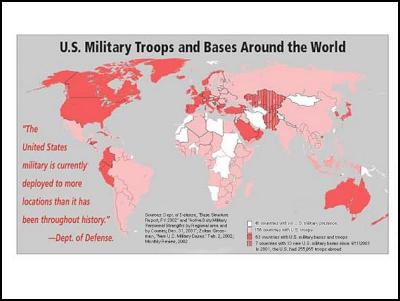
When establishment of the new United States Northern Command was announced in April 2002, one of several changes to the Unified Command Plan, the official press release declared, “For the first time, commanders’ areas of operations cover the entire Earth.” The United States military dominates the globe through its operation of 10 Unified Combatant Commands. Composed of forces from two or more armed services, the Unified Commands are headed by four-star generals and admirals who operate under the direct authority of the Secretary of Defense, accountable only to the President. Six of the Commands are responsible for designated regions of the world, and the four others for various operations. It is a mind-numbing exercise just to list them all, but in order to comprehend the breadth and depth of U.S. militarism, it is absolutely essential to be aware of their existence. They are:
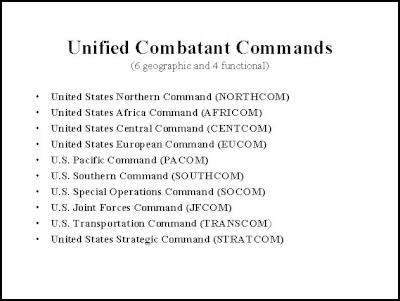
1. United States Northern Command (NORTHCOM), at Peterson Air Force Base, Colorado. Created in October 2002 in the aftermath of the September 11, 2001 attacks, it is responsible for North American homeland defense and coordinating homeland security with civilian forces.
2. United States Africa Command (AFRICOM), established February 7, 2007, in Stuttgart, Germany. To be relocated to the African continent, it is responsible for Africa excluding Egypt.
3. United States Central Command (CENTCOM), at MacDill Air Force Base, Florida, is responsible for Egypt through the Persian Gulf region, into Central Asia, and is handing over responsibility for the Horn of Africa to AFRICOM.
4. United States European Command (EUCOM), in Stuttgart, Germany, is responsible for Europe and Israel, and is handing over responsibility of Africa to AFRICOM.
5. U.S. Pacific Command (PACOM), on Oahu, Hawaii, is responsible for the Asia-Pacific region including Hawaii.
6. U.S. Southern Command (SOUTHCOM), in Miami, Florida, is responsible for South and Central America and the surrounding waters.
7.
U.S. Special Operations Command (SOCOM), at MacDill Air
Force Base, Florida,
provides special operations for the
Army, Navy, Air Force and Marine Corps.
8. U.S. Joint Forces Command (JFCOM), at Naval Support Activity Headquarters in Norfolk and Suffolk, Virginia, supports other commands as a joint force provider.
9. U.S. Transportation Command (TRANSCOM), at Scott Air Force Base, Illinois, covers global mobility of all military assets for all regional commands.
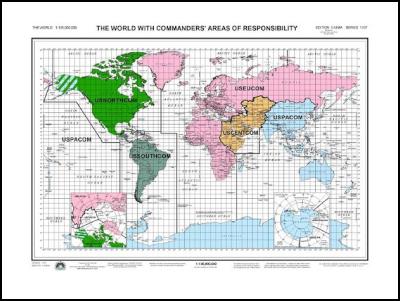
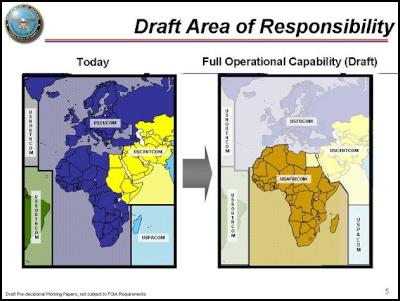
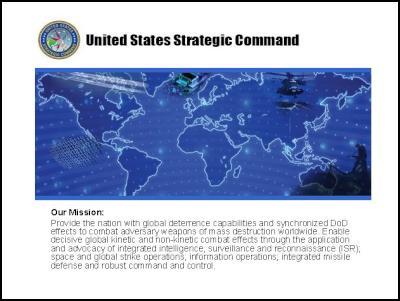
10. Tying them all together is United States Strategic Command (STRATCOM), at Offutt Air Force Base, Nebraska, which describes itself as “is a global integrator charged with the missions of full-spectrum global strike, space operations, computer network operations, Department of Defense information operations, strategic warning, integrated missile defense, global C4ISR (Command, Control, Communications, Computers, Intelligence, Surveillance, and Reconnaissance), combating weapons of mass destruction, and specialized expertise to the joint warfighter.... U.S. Strategic Command is part of a rich history that spans both the interrelated strategic and space communities.”
In testimony before the Senate Armed Services Committee just last month, StratCom Commander General Kevin Chilton testified:
“Increasingly, space-based capabilities enable all other war-fighting domains. In the 21st Century, the mindset of space as purely an "enabler" must change. We must view our activities in the space domain in the same way we regard activities in the domains of land, sea, air, and cyberspace.”
And:
“In 2007 USSTRATCOM and our Joint Functional Component Command for Intelligence, Surveillance, and Reconnaissance (JFCC-ISR) led ISR planning in support of the operational surge in Iraq.”
According to its own version of its history:
“On September 23, 1985, the Joint Chiefs of Staff confirmed the ever-increasing value of military space systems by creating a new unified command — U.S. Space Command — to help institutionalize the use of space in U.S. deterrence efforts.
The U.S.-led coalition’s 1991 victory in the Persian Gulf War underscored, and brought widespread recognition to, the value of military space operations. U.S. operations in contingencies since the early 1990s, including the Balkans, Southwest Asia, Afghanistan and Iraq have proven the military’s reliance on communications, intelligence, navigation, missile warning and weather satellite systems. Space systems are considered indispensable providers of tactical information to U.S. warfighters.”
Following
the dissolution of the Soviet Union, On June 1, 1992,
President George H. Bush established U.S. Strategic Command,
which for the first time in U.S. history brought the
planning, targeting, and wartime employment of strategic
(nuclear) forces under the control of a single commander,
while the day-to-day training, equipping and maintenance
responsibilities for its forces remained with the Air Force
and Navy.
Again, according to its own history:
“Events of Sept. 11, 2001, vividly proved that the nation needed a new strategic direction. The emergence of transnational global threats – state and non-state actors such as terrorist organizations that operate across state borders, increasingly in affiliation with others who oppose U.S. interests – required a more integrated approach to our nation’s defense. Sept. 11 also illustrated the need to improve the nation’s national command and control architecture.”
On June 26, 2002, Defense Secretary Rumsfeld announced that U.S. Space Command would merge with U.S. Strategic Command. The activation of the new StratCom took place on October 1, 2002.
Previously limited to nuclear weapons, STRATCOM’s role was expanded, consistent with provisions of the 2001 Nuclear Posture Review, to encompass all aspects of assessing and responding to nuclear, biological and chemical weapons worldwide. As military affairs analyst William Arkin warned at the time, tearing down the firewall that has separated nuclear weapons from other weapons lowers the threshold for U.S. nuclear use.
General Chilton underscored the continuing centrality of nuclear weapons in StratCom’s mission as he explained how that mission is expanding:
“While our nuclear capability remains vital, our ability to integrate conventional long-range precision weapons is every bit as important...We have a prompt global strike delivery capability on alert today, but it is configured only with nuclear weapons, which limits the options available to the President and may in some cases reduce the credibility of our deterrence.”
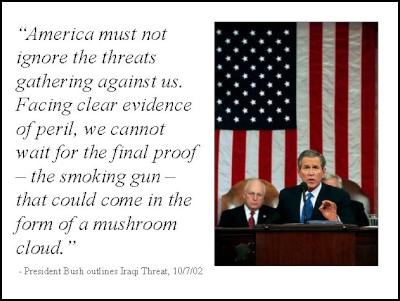

A 1993 Congressional Research Service (CRS) study of the U.S. Navy’s Naval Historical Center records identified “234 instances in which the United States has used its armed forces abroad in situations of conflict or potential conflict or for other than normal peacetime purposes” between 1798 and 1993. As the author noted, “The list does not include covert actions or numerous instances in which U.S. forces have been stationed abroad since World War II in occupation forces or for participation in mutual security organizations, base agreements, or routine military assistance or training operations.”
In a 2006 review of this study and two other surveys of U.S. military interventions, journalist Gar Smith found that “in our country’s 230 years of existence, there have been only 31 years in which U.S. troops were not actively engaged in significant armed adventures on foreign shores.” He concluded:
“The arithmetic is daunting. Over the long course of U.S. history, fewer than 14% of America’s days have been marked by peace. The defining characteristic of our nation’s foreign policy for 86% of our existence would appear to be a bellicose penchant for military intervention.
As of 2006, there were 192 member states in the United Nations. Incredibly enough, over the past two centuries, the United State has attacked, invaded, policed, overthrown or occupied 62 of them.”

Nuclear weapons, still at the core of StratCom’s mission, exist within - and not apart from - this system of extended military bases and Unified Combatant Commands, and the history it derives from. Other nations are aware of this “hidden architecture” and it figures into their own security calculations. If we are to develop effective strategies, we must understand the larger context in which the United States is modernizing its nuclear forces and developing its nuclear and conventional Prompt Global Strike capabilities today.
The Hidden Architecture of Nuclear Weapons
In an essay written after the Indian and Pakistani nuclear tests in 1998, Dr. Amulya Reddy, an eminent Indian scientist, described his visit in September 1999 to the former Nazi concentration camps in Poland, and compared these “gigantic and horrific factories of death” with the U.S. nuclear weapons infrastructure.
“[W]ith regard to the scale of the killing, the recruitment of capable minds, the harnessing of science and technology, the extent of organization, the resort to efficient project management methods, and the choice of targets to maximize annihilation of Japanese civilians – the Manhattan project and its follow-up were like the concentration camps, in fact, even more horrendous in their impact.
When talking about nuclear weapons we are not dealing with just a particularly destructive type of weapon, but rather with what President Dwight Eisenhower originally wanted to call the Congressional-military-industrial complex, to which I would add the category, “academic.” In a well-known line from the movie, “Field of Dreams,” the protagonist declares, “If you build it, they will come.” He was talking about a baseball field and the sports fans it would attract. In the same way, as we’re now seeing all too clearly, if you build a new nuclear weapons infrastructure, it will produce new nuclear weapons.
The “Reliable Replacement Warhead” (RRW) and the policy of preventive warfare didn’t spring out of nowhere. They are predictable -- possibly even inevitable -- results of policies and programs that have been in place since 1945, when President Harry Truman -- a Democrat -- ordered the first use of nuclear weapons, on two Japanese cities. These policies and programs have been reaffirmed by every administration since, whether Democratic or Republican.
It was largely during the Clinton years, following the window of unprecedented opportunity that appeared with the end of the Cold War that the use of nuclear weapons to threaten nations suspected of possessing nuclear biological or chemical weapons became a central part of U.S. “counterproliferation” policy. Presidential Decision Directive-60 (PDD-60), signed by Bill Clinton in late 1997, recommitted the U.S. to nuclear weapons as the “cornerstone” of its national security and reaffirmed the U.S. policies of threatened first use and threatened massive retaliation. PDD-60 also further institutionalized a policy shift that had been underway for some time: nuclear weapons would now be used to “deter” a range of threats including not only nuclear, but also chemical and biological weapons, another means of lowering the threshold for potential nuclear weapons use.
Clinton also brokered a deal with the nuclear weapons laboratories – the direct descendents of the Manhattan Project – to massively invest in the nuclear weapons research and production infrastructure, through the euphemistically named “Stockpile Stewardship” program, in exchange for dropping their opposition to the Comprehensive Test Ban Treaty. In the end, the Lab directors hedged in their testimony to Congress and the Senate refused to ratify the treaty. Today, under the existing Stockpile Stewardship Program, the Livermore and Los Alamos Labs are working on competing designs for so-called “Reliable Replacement Warheads” (the subject of some controversy in Congress), and “Life-Extension Programs” to render the U.S. nuclear arsenal reliable for decades to come are underway for the B61 bomb and the W76 Sea-Launched Ballistic Missile. The W-76, in fact, is being upgraded with an enhanced ground-burst capability, making it more suitable for a first strike against a hardened or deeply-buried target.
As Chalmers Johnson noted in a 2004 interview:
“[E]mpire has a much longer history than just the Bush administration, and I would be the first to argue... that Bill Clinton was a better imperialist than George Bush because he cleverly disguised what we were doing under various rubrics that he invented.... For example, Clinton argued that our attack on Serbia in 1999 was humanitarian intervention. In other cases, he disguised our imperialism as part of a newly discovered ineluctable [inevitable] process called ‘globalization’.”
The “New” Strategic Triad
The Pentagon’s December 2001 Nuclear Posture Review (NPR) – contemporaneous with the establishment of the new StratCom - underlines the fundamental policy and technological underpinnings for the Bush administration’s aggressive “preventive war” doctrine, and has served as the primary justification for each subsequent annual nuclear weapons budget request as well as the current “Complex Transformation” plan to modernize the nuclear weapons laboratories and manufacturing plants.
The NPR expanded the role of nuclear weapons in U.S. national security policy, including the possible use of nuclear weapons in “immediate, potential, or unexpected contingencies” against a seven named countries including Iraq, Iran, and North Korea, and called for indefinite retention of a large, modern, and diverse nuclear force. Significantly, the NPR also elevated the weapons research and development infrastructure – including the nuclear weapons laboratories – to one leg of the “New Strategic Triad,” intended to support both “offensive” and “defensive” nuclear and non-nuclear high-tech weapons systems that will enable the U.S. to project overwhelming global military power.
The NPR specifies: “The need is clear for a revitalized nuclear weapons complex that will: ...be able, if directed, to design, develop, manufacture, and certify new warheads in response to new national requirements.” To accomplish this, the NPR called for “Transfer of warhead design knowledge from the current generation of designers to the next generation” through an “Advanced Concepts Initiative.” This initiative has been superceded by the RRW program, an illustrative example of how programs which appear to be dead one year reemerge the next year under different names and budget lines.
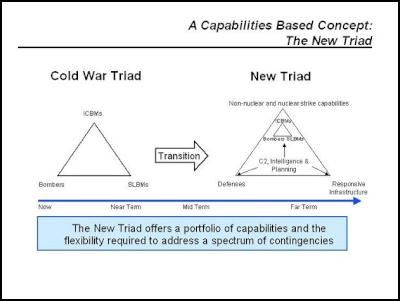
In describing the transition to a “new” strategic triad, the NPR provides a useful tool for understanding how the U.S. plans to carry out its global war fighting strategy. In one corner of the new triad, new non-nuclear weapons capabilities have been added to the “old” Cold War strategic triad, consisting of submarine- based ballistic missiles, land-based intercontinental missiles and strategic bombers – still very much there! This category has been designated “offensive strike systems.” The other legs of this new triad are “defenses” and a “revitalized defense infrastructure that will provide new capabilities in a timely fashion to meet emerging threats.” These three elements are bound together by “enhanced command and control” and “intelligence systems.
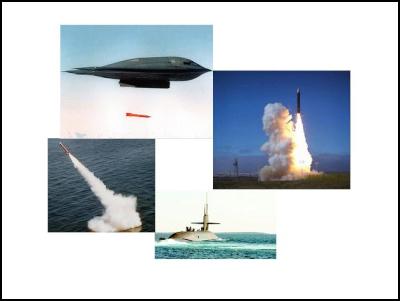
The three legs of the new strategic triad are designed to work together, to enable the United States to project overwhelming military force. A 2000 Air Force planning documents states that a long-term goal of the U.S. military is to “enable an affordable capability to swiftly and effectively deliver highly effective weapons against targets at any required global location” in order to “affordably destroy or neutralize any target on earth.…” This objective is now referred to as “Prompt Global Strike” capability.

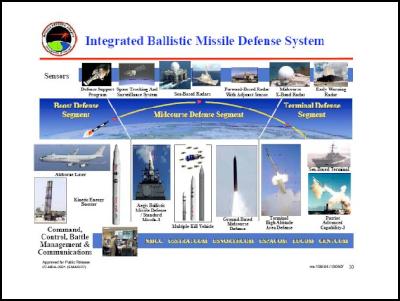
Considered in this context, it becomes easier to understand that so-called “defenses” are not really to defend the United States from a surprise attack. These systems include both “national” missile defense systems in the form of ground-based interceptors, initially in Alaska and California, and “theater” missile defenses, at foreign bases or on ships at sea. In addition, research and development is underway on laser missile defense systems, to be deployed, eventually, on airplanes and space-based vehicles. These theater missile defenses are intended to work together with the offensive weapons systems, like swords and shields, to protect U.S. troops and bases and other U.S. “strategic assets” around the world. Admiral Ramu Ramdas, the former head of India’s navy and now a leading proponent of nuclear abolition has described U.S. theater missile defenses as a “net thrown over the globe.”
An illustrative version of this concept can be found in a 2002 speech by the U.S. Chief of Naval Operations, who was promoting a program called “Sea Shield:”
“What Sea Shield does is extend homeland security to the fullest extent with forward deployed forces, buying time and buying space for the detection and tracking of threats headed toward our country...
As we look to the future, Sea Shield’s littoral [shoreline] control capabilities will build upon rich mix of manned and unmanned systems on, over, and below the sea. This combination of platforms, sensors, and weapons will assure access and provide the foundation of battlefield dominance.
Perhaps the most radical change embedded in Sea Shield will be the ability to project defensive firepower deep over land. New technologies will allow sea based missiles to engage enemy air targets far over the horizon, before they can threaten joint and coalition forces operating ashore.”
One of the main goals of the policies and programs endorsed by the NPR is to make U.S. threats of force, including nuclear threats, more credible: more powerful conventional forces for use where nuclear weapons would be untenable and more useable nuclear weapons where nothing else has sufficient power to intimidate or destroy. Nuclear weapons are not segregated either operationally or doctrinally from conventional weapons.
Delivering the Warheads to Their Targets
Too often, in nuclear weapons discourse, a disproportionate amount of attention is focused on warhead modifications. Yet a nuclear warhead is relatively benign by itself; it needs to be delivered to its target. Though largely unreported by the media and unknown to the public, the United States routinely conducts long-range missile tests. Between January 2000 and July 2006, the U.S. conducted at least 48 tests of intercontinental ballistic missiles (ICBMs) and submarine launched ballistic missiles, including some 23 Minuteman III ICBMs, launched from Vandenberg Air Force Base in California. In a June 14, 2006 news release, the Air Force spokesman explained:
“While ICBM launches from Vandenberg almost seem routine, each one requires a tremendous amount of effort and absolute attention to detail in order to accurately assess the current performance and capability of the Nation’s fielded ICBM force that is always on-alert in Montana, North Dakota, Wyoming, Colorado and Nebraska. This specific test will provide key accuracy and reliability data for on-going and future modifications to the weapon system, which are key to improving the already impressive effectiveness of the Minuteman III force.” (emphasis added)
On July 20, 2006, less than a week after the United Nations Security Council unanimously adopted a resolution condemning North Korea for test launching several shorter-range ballistic missiles, the United States launched an unarmed Minuteman III intercontinental ballistic missile from Vandenberg. The missile, carrying three dummy warheads, was fired 4,200 miles across the Pacific toward the missile test range at Kwajalein Atoll in the Marshall Islands, with a flight time of about 30 minutes. All three of the dummy warheads hit their pre-determined targets.
Meanwhile, also largely unnoticed, with StratCom’s full support, the Pentagon and its contractors are poised to begin development of a new generation of long range delivery systems, capable of carrying either conventional or nuclear warheads. Such systems, intended primarily to increase the already formidable U.S. advantage in conventional weapons, may in the long run be more dangerous than proposed improvements in nuclear warheads. The U.S. government is also considering options for replacement of the intercontinental ballistic missiles that are the core of the U.S. nuclear arsenal. New delivery systems for nuclear weapons would involve many of the same technologies that would be developed for long-range missiles carrying non-nuclear payloads. These technologies could provide the building blocks for new nuclear capabilities, particularly in combination with warhead modifications now in progress or under consideration.
The Future of Nuclear Weapons
Some argue that “Stockpile Stewardship” and “Complex Transformation” are merely a “make work” program for scientists and engineers, or that the nuclear weapons we already have are not “useable.” But, as documented by author Joseph Gerson, every U.S. President, Republican and Democrat, has prepared and threatened to initiate nuclear attacks. This has happened on more than thirty occasions during international crises, confrontations and wars, primarily to reinforce U.S. hegemony in the East Asia and the Middle East. Consider also the following passage from an August 2006 Pentagon planning document:
“Within Global Strike, US nuclear forces contribute uniquely and fundamentally to deterrence -- through their ability to threaten to impose costs and deny benefits to an adversary in an exceedingly rapid and devastating manner. Nuclear weapons provide the President with the ultimate means to terminate conflict promptly on terms favorable to the US.” (emphasis added)
Very recently, StratCom Commander General Kevin Chilton told reporters:
“As we look to the future – and I believe we are going to need a nuclear deterrent for this country for the remainder of this century, the 21st century – I think what we need is a modernized nuclear weapon to go with our modernized delivery platforms.” (emphasis added)
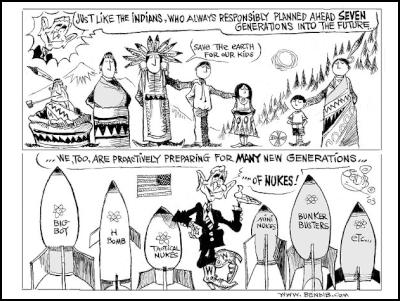
Follow the Money
Another not so hidden part of the architecture of U.S. militarism is the incredible amount of money the U.S. has spent - and is spending - on its military enterprise.
“Atomic Audit,” a study by the Brookings Institution completed in 1998, found that, as a conservative estimate, the United States spent $5.5 trillion dollars on nuclear weapons alone, from 1940–1996 (in constant 1996 dollars.) The Brookings study found that nuclear weapons spending during the 56 year period it examined exceeded the combined total federal spending for education; training, employment, and social services; agriculture; natural resources and the environment; general science, space, and technology; community and regional development, including disaster relief; law enforcement; and energy production and regulation. On average, the study estimated, the United States spent $98 billion a year on nuclear weapons.
The NNSA’s Fiscal Year (FY) 2009 budget request for nuclear weapons research, development, and testing activities is $6.6 billion, more than 5% over the prior year’s appropriation, Even after accounting for inflation, this is more than one-third higher than the average annual spending on nuclear weapons during the Cold War. However, this figure does not include delivery systems or command and control technologies, which are funded separately through the DoD. Many of the Pentagon programs are “dual use,” meaning shared with conventional weapons systems, which complicates assessment of the total budget.
The Center for Strategic and Budgetary Assessments estimates that the United States currently spends approximately $54 billion annually on all nuclear-related programs and activities including offensive and defensive capabilities, Department of Defense and Department of Energy activities, strategic and theater forces, as well as associated command, control and communications capabilities. That is more than the entire military budget of nearly every individual country in the world. In 2006, only China ($121.9 B), Russia ($70.B), the United Kingdom ($55.4B), and France ($54.B) spent $54 billion or more in total on their militaries.
What else could $54 billion a year be used for? According to the 1998 United Nations Development Program report, the additional cost of achieving and maintaining universal access to basic education for all, basic health care for all, reproductive health care for all women, adequate food for all, and clean water and safe sewers for all would amount to roughly $40 billion a year.
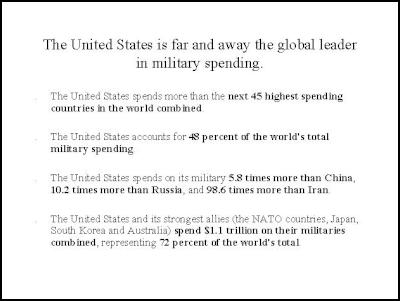
On February 4, the Bush administration released its budget request for Fiscal Year 2009, which begins Oct. 1, 2008. For FY 2009, the White House is seeking $711 Billion for the military - $541 for the Pentagon and the nuclear weapons-related activities of the DOE, and according to Defense Secretary Robert Gates, at least $170 Billion for ongoing military operations in Iraq and Afghanistan.

Redefining Security
In its June 2006 report, Weapons of Terror: Freeing the World of Nuclear, Biological and Chemical Arms, the Hans Blix-led Weapons of Mass Destruction Commission recommended, “All states possessing nuclear weapons should commence planning for security without nuclear weapons.” But, while advocating, “preparing for the outlawing of nuclear weapons through joint practical and incremental measures…” the Commission did not directly address what “security without nuclear weapons” means.
One rather disquieting view of security without nuclear weapons was offered last year by Robert Einhorn, a Clinton administration nuclear policy expert and arms control advocate. “We should be putting far more effort into developing more effective conventional weapons,” he said. “It’s hard to imagine a president using nuclear weapons under almost any circumstance, but no one doubts our willingness to use conventional weapons.” This statement, unfortunately, is all too true. But an even more overpowering conventional U.S. military threat surely is not the desired outcome of the nuclear disarmament process. Moreover, how practical would that approach be? How would countries with fewer economic resources - especially those on the “enemies” list - respond? Wouldn’t they have an incentive to maintain or acquire nuclear weapons to counter overwhelming U.S. conventional military superiority? And wouldn’t that, in turn, even further entrench U.S. determination to retain and modernize its own nuclear arsenal, thus rendering the goal of nuclear disarmament nearly impossible? This conundrum is one of the biggest challenges we face and it cannot be ignored.
To its credit, the Blix Commission ended its report by acknowledging: “The perspective of a world free of WMD must be supplemented by the perspective of a world in which the arsenals of conventional weapons have been reduced drastically.” The Commission concluded:
“Tensions between rich and poor societies, the spread of diseases like HIV and avian flu, environmental threats, competition over energy, the functioning of international trade and financial markets, cross-border crime and terrorism, and so forth, will be challenges for all. They will require the development of an international society organized through cooperation and law rather than one controlled by overwhelming military force, including weapons of mass destruction.”
Conclusion
As an outspoken advocate for the abolition of nuclear weapons for more than a quarter of a century, I have often been called idealistic. Yet I believe that the case I’ve presented here for the necessity of placing nuclear weapons in the broader context of the United States history of militarism and its powerful entrenched nuclear weapons establishment is highly realistic.
In May 2007, Western States Legal Foundation, Lawyers’ Committee on Nuclear Policy and the Reaching Critical Will project of Women’s International League for Peace and Freedom released a book entitled, Nuclear Disorder or Cooperative Security? U.S. Weapons of Terror, the Global Proliferation Crisis and Paths to Peace, in response to the WMD Commission report.
In a chapter entitled, “Redefining Security in Human Terms,” I grappled with the problem of relating abolition of nuclear weapons to demilitarization and a new concept of security. My conclusion is that a paradigm shift is called for; a fundamental reconceptualization of security, from which a new system can emerge, from the bottom up. My recommendations:
- The concept of security should be reframed at every level of society and government, with a premium on universal human and ecological security, a return to multilateralism, and a commitment to cooperative, nonviolent means of conflict resolution.
- Nuclear disarmament should serve as the leading edge of a global trend towards demilitarization and redirection of military expenditures to meet human and environmental needs. The United States government has a special responsibility to take leadership in this massive undertaking.
The United States government, however, will not take leadership in this massive undertaking without a massive nonviolent demand from below. And we Americans can’t create that demand alone. We, the ordinary people of the world, must recognize that we are all in this together!


 Eugene Doyle: Quiet Mutiny - The U.S. Army Falls Apart
Eugene Doyle: Quiet Mutiny - The U.S. Army Falls Apart Gordon Campbell: Papal Picks, And India As A Defence Ally
Gordon Campbell: Papal Picks, And India As A Defence Ally Binoy Kampmark: The Selling Of America - Ending The US Dollar’s Exorbitant Privilege
Binoy Kampmark: The Selling Of America - Ending The US Dollar’s Exorbitant Privilege Frances Palmer: Remembering Vietnam And Cambodia 50 Years On During ANZAC Week
Frances Palmer: Remembering Vietnam And Cambodia 50 Years On During ANZAC Week Binoy Kampmark: Euphemistic Practices - The IDF, Killing Aid Workers And Self-Investigation
Binoy Kampmark: Euphemistic Practices - The IDF, Killing Aid Workers And Self-Investigation Gordon Campbell: On The Left’s Electability Crisis, And The Abundance Ecotopia
Gordon Campbell: On The Left’s Electability Crisis, And The Abundance Ecotopia